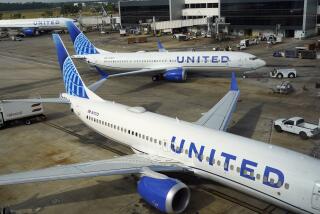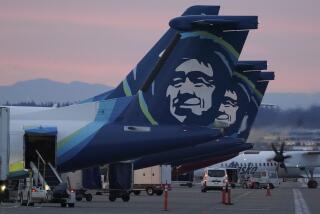WIND AND A PRAYER
- Share via
JUNEAU, Alaska — Nestled at the foot of several mountain ranges and frequently engulfed in fog and blasted by chaotic winds, Juneau International Airport is being transformed from an intimidating place to land an aircraft into the nation’s leading test bed for new airport technology.
The airport, serving Alaska’s capital city, is expected to become the first in the world with an integrated system that will give pilots a complete picture of winds and weather conditions from the sea-level landing strip to more than a mile above the mountains next to the airport.
The system includes a network of ground-based wind gauges plus radar “profilers” that will measure winds at higher altitudes, and a satellite navigation system that will pinpoint the position of approaching airliners more accurately than any ground-based system. It is expected to become the model for the rest of the world, and it is being installed her partly because scientists believe that if they can do it here, they can do it anywhere.
A massive field of ice, called the Juneau Icefield, stretches over hundreds of square miles east of the mountains that line the airport. Cold air descending over the mountains picks up speed as it drops toward sea level, just like water spilling over a dam. It hits the ground and washes up the sides of the mountains like water sloshing from a bowl, creating wind currents that can only be described as weird. Wind velocities of more than 100 mph are not uncommon, especially in winter. And it can be calm in one area and howling just a couple of miles away.
The pilot of a small plane found that out the hard way recently. He tried to approach the runway from one direction but encountered tail winds too strong for him to land. So he went around and tried to come in from the other direction, only to find strong tail winds there as well.
“I wouldn’t have believed it myself if I hadn’t seen it with my own eyes,” said David C. Miller, a retired Air Force pilot and manager of the airport. And just as odd, the wind was blowing directly across the runway near its center.
The pilot landed by aiming for the center of the runway and then making a sharp turn into the wind just before his wheels touched down.
Stories like that have made the airport infamous, and they have not always had such a benign ending.
Over a 24-year period, three Juneau-bound aircraft have crashed within 11 miles of one another on a range of mountains less than 30 miles northwest of the airport. There were no survivors.
All three aircraft were receiving erroneous navigational signals that indicated that they had already cleared the rugged Chilkat Mountains, so they descended prematurely. An Alaska Airlines 727 crashed Sept. 4, 1971. On Nov. 12, 1992, a National Guard plane crashed near the same site. And a Lear jet crashed nearby Oct. 22, 1995.
Nearly four years after the 1992 crash, another Alaska Airlines pilot narrowly avoided a disaster. The airliner had just taken off and had made a sharp turn at the end of the runway to avoid the mountains to the south when it was hit by a severe downdraft.
“It got down to about 250 feet before the pilot recovered,” Miller said. That put it nearly at treetop level above Douglas Island, and it narrowly cleared the house where Miller now lives.
“It was a very scary incident,” he said.
Chiefly because of that near-tragedy, and a growing understanding of wind shear, the Federal Aviation Administration early this year closed down two departure routes out of the Juneau Airport. Since then, numerous flights have been grounded intermittently, further isolating the capital, which can be reached only by air or sea.
That move accelerated efforts in Juneau to upgrade the airport, and it brought in outside sources eager to show that new technology can make any airport much safer.
* The airport used to have only one wind gauge, but now it has installed them throughout the area, even on the tops of the mountains that encircle Juneau. Readings are fed into a computer that provides a complete picture of surface winds throughout the region.
* The National Center for Atmospheric Research in Boulder, Colo., has installed two wind profilers within eight miles of the airport that measure wind velocities from the ground up to 12,000 feet. The profilers are radar systems that point straight up, bouncing signals off particles--such as rain or snow--carried by the winds. The echoes tell scientists which way and how fast the wind is blowing at intervals of 200 feet.
* Alaska Airlines, the only major carrier that serves Juneau, is investing $10 million in receivers for the Global Positioning System that will use the satellites to pinpoint the positions of its aircraft. Ground-based navigational aids, including radar, are far less reliable because of interference from the rugged terrain.
The wind gauges are operational, and the system is one of the most comprehensive ever established at an airport.
Wind profilers are still considered experimental in most quarters. They have been used in the past, mostly to gather measurements of air pollution, but never as an integrated airport warning system.
“Juneau may be the first operational use of this technology [at an airport] anywhere in the world,” said Larry Cornman, a physicist with the National Center for Atmospheric Research who is leading the program.
For four years, Cornman’s organization has been developing a similar system for a new airport in Hong Kong, but that airport is not expected to begin operations until next year. He hopes to have Juneau’s system operational late this year, provided that further tests demonstrate the reliability of the technology. A similar program is in the planning stages for the Colorado Springs airport, but it is not expected to be up and running until after the Juneau project is operational, Cornman said.
Alaska Airlines has installed dual satellite systems in three of its airliners, and expects to have 24 equipped by the end of the year. Although such systems have been used aboard ships and military aircraft for several years, the FAA is still evaluating their reliability in tight quarters, such as approaching and departing airports.
The system has been judged reliable enough to permit Alaska Airlines to participate in a new FAA program that will allow pilots to pick their own routes in Alaska rather than depend on ground-based air traffic controllers.
“We can guarantee that we will be within two-tenths of a mile” from where the pilots think they are, said Douglas Wahto, an Alaskan Airlines pilot who is spearheading the Juneau project. Ground-based navigational technology tells the pilot only that he is within a “box” that could be as much as eight miles wide, Wahto said.
The system is expected to lead to eased restrictions on departure routes, thus reducing the airline’s flight cancellations or delays by 75% to 85%, Wahto said. That could save the airline enough in less than two years to pay for the entire project. But more important, it will provide the pilots with a visual image of where they are, and how far they are from the mountains and the runway.
More to Read
Sign up for Essential California
The most important California stories and recommendations in your inbox every morning.
You may occasionally receive promotional content from the Los Angeles Times.












